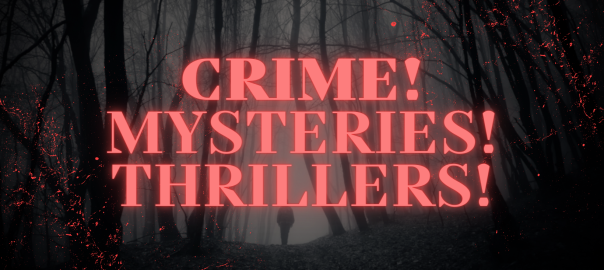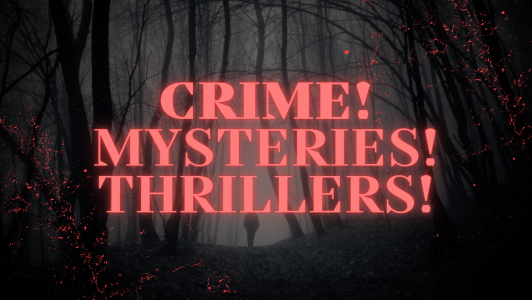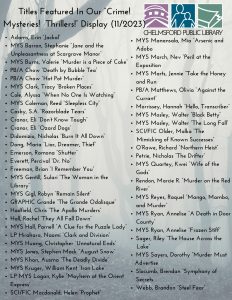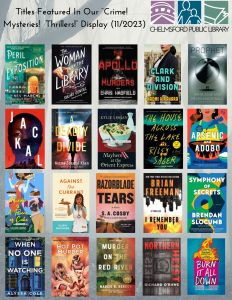
Crime! Mysteries! Thrillers! Display

Loads of people like to read mysteries, crime novels, and thrillers, but do you know the differences between them? Mysteries follow clues to reveal the person who committed a crime. They can be standalone or part of a series. Dorothy Sayers is a classic example of a mystery writer with a long-running series in her Lord Peter Wimsey books. Within the mystery genre, there are several subgenres, including cozy mysteries like Jennifer Chow’s “Death By Bubble Tea,” hardboiled mysteries like those by author Walter Mosley, police procedurals such as “Wife of the Gods” by Kwei Quartey, and speculative mysteries that are set in a science fiction or fantasy setting. Mystery novel themes include “proving one’s innocence,” “solving the puzzle,” featuring famous characters, and “rookie on the beat.” “The Woman in the Library” by Sulari Gentill is a great example of a “solve the puzzle” mystery, while Stephanie Barron’s Jane Austen mysteries will appeal to Austen lovers out there. You may like one of these mystery subgenres more than another, so don’t give up after just reading one mystery novel–you might not have found your subgenre yet!
Thriller subgenres include legal thrillers such as Robyn Gigl’s “Remain Silent,” psychological thrillers written by authors like Alyssa Cole, supernatural thrillers, and spy fiction. “Shutter” by Ramona Emerson is a great example of a supernatural thriller, while “Prophet” by Helen Macdonald and Sin Blanche falls into the spy fiction subgenre. Thrillers might feature unreliable narrators, like in Mara Dong’s “Liar, Dreamer, Thief.” They might have a plot that seems “too good to be true,” like in Riley Sager’s “The House Across the Lake.” Thrillers are often set “behind the Iron Curtain” or in a similar setting. “The Apollo Murders” by Chris Hadfield is a great example of this theme. Thrillers might also feature missing memories, as found in Brian Freeman’s “I Remember You.” Again, one of these themes may appeal to you more than another, so you may need to try reading a few thrillers to really get a feel for what you like.
Crime fiction subgenres include rural noir, capers, organized crime, and “inspired by read events.” S.A. Cosby’s “Razorblade Tears” is a great example of rural noir, while “Dr. No” by Percival Everett is a classic caper novel. A recent example of organized crime is “The Plotters” by Un-Su Kim. “Northern Heist” by Richard O’Rawe is inspired by real events. Within the crime novel genre, popular themes include “on the run,” “criminal masterpieces,” “rural noir,” and “vengeance is mine.” If you’re looking for a new “on the run” title, try “Burn It All Down” by Nicholas DiDomizio. Another great rural noir title is “Barbed Wire Heart” by Tess Sharpe. If you like the “vengeance is mine” theme, try “How to Kill Your Family” by Bella Mackie.
Never read a mystery and are looking to try one? I recommend Jessa Maxwell’s “The Golden Spoon.” Think Great British Bakeoff but with a murder to solve. If you think a thriller might be what you need, “What Never Happened” by Rachel Howzell Hall fits the bill. If you’re looking for a classic crime novel, try “Confidence” by Rafael Frumkin. These are all great “first books to try” within these genres.
There are also lots of movies, TV, and podcasts tied to these genres as well. In fact, thriller novels are often made into movies or TV shows. Since these genres are some of my favorites, I’m also keeping an eye on what S.A. Cosby, Mia P. Manansala, Erin E. Adams, and Eli Cranor are writing. These are some authors to watch when it comes to your mysteries, thrillers, and crime novels.
Visit our display area to find these titles and lots more. Lists of featured titles are also below.








